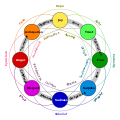
Determination is a positive emotional feeling that promotes persevering towards a difficult goal in spite of obstacles. [2] [3] Determination occurs prior to goal attainment and serves to motivate behavior that will help achieve one's goal.
Contents
- Etymology
- Major theories
- Self-determination theory
- Biopsychosocial model
- Appraisal theory
- Empirical findings
- Emotional experience
- Emotional expression
- Intrinsic and extrinsic motivation
- Applications
- Classroom, workplace, and family environment
- Health and well-being
- Interpersonal relationships
- See also
- References
Empirical research suggests that people consider determination to be an emotion; in other words, determination is not just a cognitive state, but an affective state. [4] In the psychology literature, researchers study determination under other terms, including challenge and anticipatory enthusiasm; this may explain one reason for the relative lack of research on determination compared to other positive emotions. [3] [5]
In the field of psychology, emotion research focuses on negative emotions and the behaviors they prompt. [6] However, positive psychology delves into determination as a positive emotion driving people toward action, leading to significant results like persistence and success.
| Part of a series on |
| Emotions |
|---|
  |